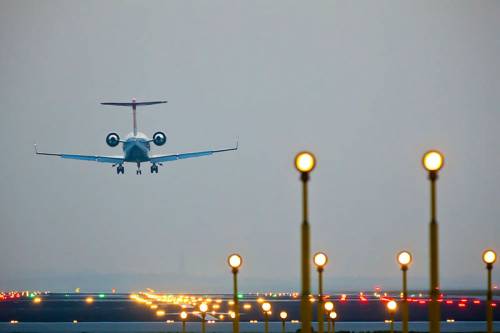Brussels Airport infrastructure
The runways and their names
Brussels Airport has three runways that can be used in both directions for take-off as well as for landing. That means that there are 6 ways to take off or land.
Two runways are almost parallel to each other: 25 Left and 25 Right. When used in the opposite direction, they are called 07 Right and 07 Left. The runway crossing the two parallel runways is runway 01. In the opposite direction it changes its name to runway 19.
The names of the runways are derived from the compass. From the pilot’s point of view an aircraft approaches, for instance, from the east at 250° on compass. The last 0 is omitted and so it becomes runway 25. The indications Left and Right are also seen from the pilot’s point of view: depending on the direction from which the aircraft approaches, a runway is situated at the right- or the left-hand side.
Precision and non-precision approaches
Precision approach
Runways 25L, 25R, 19 and 01 are equipped with an ILS ( Instrument Landing System ). Such a system provides lateral and vertical guidance to the pilots. This techology allows approach and landing operations in low visibility (and low cloud ceiling) conditions.
Approach procedure with vertical guidance (APV)
Approach procedures relying on satellite navigation systems (i.e. GPS), are being published for all runways. These procedures provide lateral and vertical guidance to all aircraft with the capability to fly them. The operational minima (visibility and/or ceiling) however, are higher than those applicable for precision approaches.
Non-precision approach
For runways 07L and 07R, being not fitted with an ILS-installation, so-called non-precision approaches are published, relying on a radio navigational aid called VOR/DME. This technology provides lateral guidance only to the pilot, and the distance of the aircraft to the beacon, but not to the runway threshold. Due to these limitations, the operational minima (visibility and/or ceiling) for these approach procedures are higher than those applicable for precision and APV approaches.
The VOR/DME beacon is not located in the extended axis of runway 07L. Therefore an offset VOR approach is published, which requires arriving aircraft to make a final turn just before landing. This procedure is not allowed to be flown at night and, in case of strong easterly winds, runway 07R should then be used for arrivals.
Taxiways
Taxiways connected to a runway are called exit taxiways. When the orientation of such exit taxiways continue in the same direction of the landing aircraft and are long enough so that the aircraft is able to reduce quite some speed, we call them rapid exit taxiways. The more of these rapid exit taxiways, the more performing the operations are.
Runway 07R, however, has no rapid exit taxiway at all. Moreover, on the last part of the runway, there is not even any exit taxiway anymore. That is why an aircraft has to make a U-turn at the end in order to return to the last exit.

Crossing runways and capacity
The ideal situation consists of a departing aircraft not having to wait for a landing aircraft (or vice versa). That is the case when runways 25R and 25L are being used.
Air traffic controllers have to be able to keep a bird’s-eye view of all traffic at all times, on the ground as well as in the air. The use of crossing runway operations increases the air traffic control complexity. Of course, capacity suffers from the use of crossing runways, but safety always comes first.